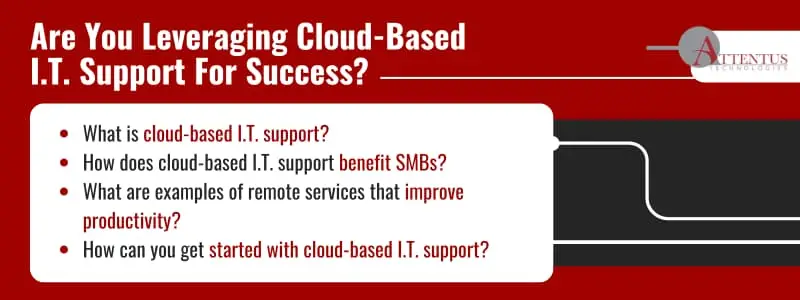Businesses worldwide are moving from traditional I.T support to cloud-based models to meet today’s demands for flexibility, security, and scalability.

Imagine your I.T team solving most issues instantly, without ever needing to step foot in your office.
Over the last few years, the way businesses get I.T. support has changed dramatically to accommodate flexibility, security, and fast-paced growth requirements.
Forward-thinking SMBs now use some form of remote I.T. support or cloud-based solutions to maintain operations efficiently. These companies have realized that cloud-based I.T. support isn’t just a convenience, but rather something that creates a strategic advantage.
Let’s explore why that’s the case.
What Is Cloud-Based Remote I.T. Support?
You probably had only a few employees and computers when you started your business, and that made I.T. easier to manage. But keeping track of I.T. issues has likely become a little more troublesome as your business expands, requiring strategic solutions.
That’s where cloud-based I.T. support comes in.
Cloud-based I.T support is a remote service model where your technology partner uses cloud solutions to monitor, access, troubleshoot, and secure your systems without being onsite. This approach delivers proactive maintenance and rapid incident response, keeping your SMB productive and protected.
Cloud-based I.T. support services typically rely on
- A remote monitoring and management (RMM) tool
- Cloud-hosted help desk and ticketing
- Secure access to endpoints and servers
Your managed service provider (MSP) implements an RMM tool made of two components: a lightweight agent installed on each device you want to monitor, and a centralized dashboard where the I.T. team can view everything in real time.
The agent instantly collects key data, such as CPU usage, disk space, and antivirus status and sends it to the dashboard, giving your I.T team a complete, real-time view.
This allows your cloud-based I.T. support provider to continuously monitor your systems’ health and get instant alerts when there’s a potential issue coming so they can proactively mitigate it.
The RMM tool also lets you remotely manage updates, patches, and configurations. Windows typically releases security patches for supported operating systems on Patch Tuesday (every second Tuesday of the month), for example, and the RMM tool can help check that all your computers are up to date.
It can also notify your MSP of any device that didn’t update, so they can further investigate why the update didn’t run, remediate issues, and push updates through.
The RMM tool helps automate routine maintenance tasks, too. If you have multiple computers in your business and you want to make sure they’re rebooted once a week, for example, your MSP can automate that with the RMM tool.
Cloud-hosted help desk, ticketing, and secure access to endpoints and servers are the final pieces of the puzzle, ensuring your team can reach your MSP remotely at any time and receive secure I.T. support.
Action item: Ask your MSP if they offer 24/7 monitoring through cloud-based tools (and what’s included).
Core Advantages for SMBs
There are four justifications for embracing cloud-based I.T. support.
-
Speed of resolution
Problems are fixed faster without waiting for on-site visits. Let’s say you have a fix that needs to be applied or software that needs to be installed on computers in your organization. Your MSP can take that one piece of software and, with a click of a button, install the software across all of your computers.
-
Cost savings
Because your MSP can work on your systems remotely through RMM tools and cloud solutions, travel costs disappear, and you save both money and time.
-
Scalability
You can easily and quickly add or remove users as your team changes and at your own convenience.
-
Security benefits
Cloud-based IT support strengthens your defenses with modern security layers, including encrypted remote connections, role-based access, and real-time threat monitoring ensuring your systems stay protected against evolving threats. These ensure that communications aren’t intercepted, that only authorized people access systems, and that you can proactively detect and address malware and other threats before they cause damage.
Action item: Calculate the average time it takes your current I.T. provider to resolve an issue and compare it to the SLA of a cloud-based provider. Request a monthly security report from your MSP to track performance.
Remote Services That Improve Productivity
Looking to instantly boost your team’s productivity? Consider implementing these three remote services:
- Cloud-based file sharing and collaboration tools
- Unified communications platforms, such as VoIP
- Automated updates and patch management
These services enhance team collaboration and client communication while ensuring every interaction happens in a secure, reliable environment.
I.T. Support Shouldn’t Be Limited by Location
Waiting for support to show up on-site is costly and inefficient in today’s market. Why do that when you could leverage cloud-based I.T. support?
Remote services are now the backbone of resilient businesses, helping them stay productive, protected, and ready for change no matter where their team works.
It’s time to join the front runners.
Action item: List your team’s top three recurring tech frustrations and check on whether remote services can remove those pain points.
Leverage Cloud-Based I.T. Support
One of our core values at Attentus Technologies is to be the answer by offering practical remote services to businesses with distributed teams, high uptime needs, and growth plans that demand flexible support.
Our cloud-based I.T. support services help you:
- Proactively monitor and maintain your systems for high performance
- Access fast remote resolution, backed by onsite support when needed
- Integrate cloud solutions for enhanced communication, storage, and security
Want faster, more secure I.T. support without the wait? Let’s explore a cloud-based support model tailored to your business. Book your consultation today!
